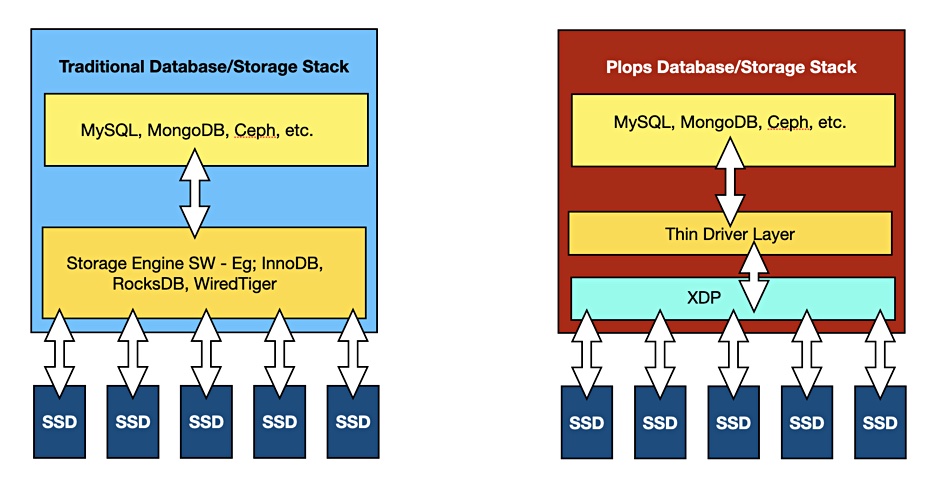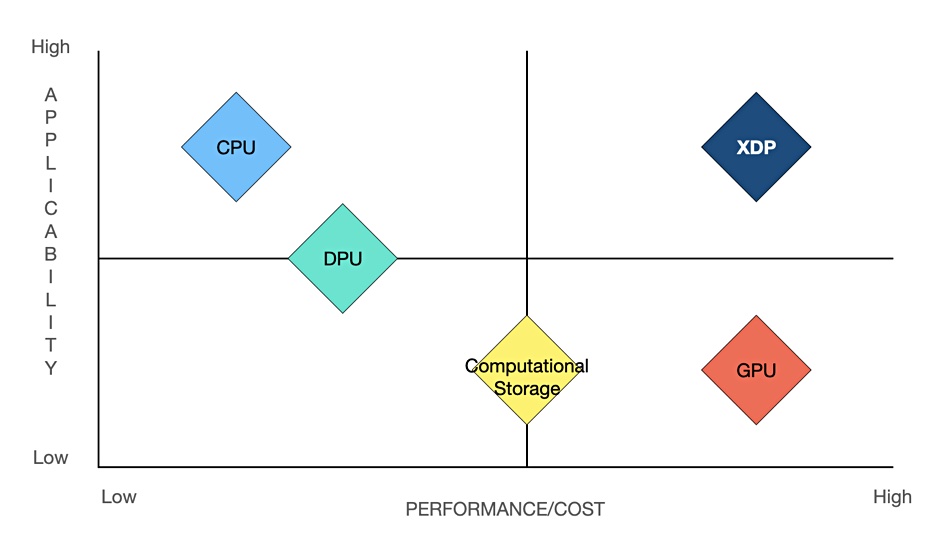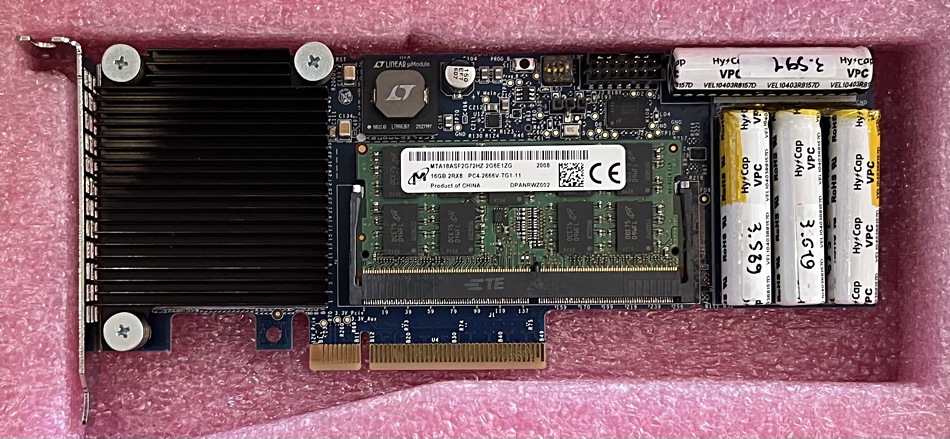Israeli startup Pliops wants to replace the existing block interface to SSDs, based on disk drive-era thinking, with key:value store technology that enables vastly more efficient SSD operation. It claims this will accelerate data access and prolong an SSD’s working life.
Pliops’s founders realised that a server’s low-level storage functions could be pushed down the stack to a reinvented SSD controller – one that replaced the existing FTL (Flash Translation Layer). The company was started up in 2017 to develop this storage offload technology for x86 servers comprising a PCI bus-attached card called an eXtreme Data Processor (XDP). It is built with FPGA chips, NVDIMMS and DRAM, and carries out the processing performed by storage engine software used by Ceph, Relational, and NoSQL databases such as MongoDB.

Co-founder and CEO Uri Beitler said Pliops wants to become the Nvidia of storage, by increasing infrastructure scaling for databases, analytics, AI and other data-intensive applications. So it’s built a specialised processing engine to do it.
In an IT world getting flooded with SmartNIC, IPU (Intel), DPU (Fungible, Nvidia and others) and computational storage announcements, how do we place its XDP in the market? A Pliops slide showed a positioning diagram which we have reproduced:

Beitler presented a session at an IT Press Tour event in Tel Aviv covering Pliops’s situation and progress. He said: “We complement both DPUs and computational storage.” How so?
Computational storage drives, like ones from ScaleFlux, operate at the per-drive level. Pliops’s XDP effectively replaces a storage array controller, operating across a set of drives with up to 64TB of total raw capacity. It improves their overall I/O performance, extends individual drive endurance, increases effective capacity through compression, and provides RAID-like protection against drive failure.


DPUs like Fungible’s chips include networking functions – Fungible’s TrueFabric. Beitler said: “We have no networking capabilities [and] we are working with DPU developers today.”
On launch in July 2021, the XDP delivered up to 3.2 million random read and 1.2 million random write IOPS and could store up to 128TB of data on 64TB of SSD capacity through compression. It supports QLC (4bits/cell) flash drives, also Optane SSDs, and has block and key:value store interfaces to its server host applications. Block is basically treated as an overlay on the underlying key:value technology and is still faster, Beitler said, than other suppliers’ block-interface SSDs.
It sells its product to hyperscaler businesses and large enterprises who find their x86 servers bogged down with getting masses of data to their processors, limited in data access speed, suffering short SSD endurance and high cost. Pliops says it has gained early traction – counting a global top five SaaS provider in China as a customer and a top five hyperscaler with an IaaS offering. There is also a Top500 HPC customer. None of these can be named yet.

They all get, Pliops said, significant TCO savings. Steve Fingerhut, Pliops’s chief business officer, said the top five SaaS provider used to have RAID-protected racks of servers and storage – 2x 15.84TB SSDs per server with 21TB usable. Now it has servers fitted with the XDP and 4x 15.84TB SSDs with 64TB usable. It suffers zero server stoppages due to SSD failures – the XDP has RAID functions – which was a fairly frequent occurrence before with the hundreds if not thousands of servers in its estate. There has been a 58 per cent reduction in TCO/TB of user data and a 33 per cent increase in the multi-tenancy of its database instances.
We are told Pliops is making good progress in talking to US-based hyperscalers – CSPs and enterprises both. The early progress in China has yielded Inspur becoming an OEM.
Roadmap
The company is developing its second generation XDP and this will feature PCIe 5 support, and higher raw capacity – possibly 128TB. There will also be support for SDXI and TP-4091.
SDXI (Smart Data Accelerator Interface) support is an SNIA proposed standard for a memory to memory Data Mover interface. The SNIA says software memcpy is the current data movement standard for software implementation due to stable CPU ISA (Instruction Set Architecture). However, this takes away from application performance and incurs software overhead to provide context isolation. Offload DMA engines and their interfaces are vendor-specific, and not standardized for user-level software.
A Plops slide showed SDXI and TP-4091 linked to Arm servers, which have a non-x86 ISA.
ScaleFlux chief scientist Tong Zhang said: “In order to off-load certain computational tasks into computational storage drives, host applications must be able to adequately communicate with computational storage drives. This demands the standardised programming model and interface protocol, which are being actively developed by the industry (e.g., NVMe TP 4091, and SNIA Computational Storage working group).”
Pliops says it is also moving from FPGA to ASIC technology
Investors and partners
Pliops has taken in $115 million in funding with the latest round being for $65 million last year. Its investors include AMD, Intel Capital, Nvidia, SoftBank and Western Digital, which also uses Pliops in-house for a Redis application.
Beitler said Pliops is partnering with all the main SSD vendors and also working with Nvidia in two ways. One is to have an XDP-fronted NVMe drive shelf using BluefIeld smartNICs to talk to host systems. The second is to have the XDP NVMe drive shelf link directly to an Nvidia GPU server, in much the same way as a VAST Data array might.

He said Pliops is also working with DPU developers today as well as SSD vendors. It doesn’t work at the moment with file system suppliers. Pliops chairman Aryeh Mergi said: “At a low level they use key:value stores and we are applicable. We just don’t work with them today.” WEKA and Google-acquired Elastifile were cited as key:value store technology users. Mergi said Pliops is focussing more on open source software, like Ceph and “most file systems are proprietary.”
Pliops also works with WD on the zoned name space initiative. The XDP batches up random writes and sends them to the SSD as sequential blocks, reducing write amplification and treating the SSD as a single zone. Theoretically it would be easy to divide an SSD up into logical zones and manage them separately.
It seems to Blocks & Files that Pliops has been operating in a quiet mode – under the radar so to speak – but it hinted that named customer case studies were coming. We expect to hear much more from Pliops as the year progresses.








